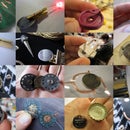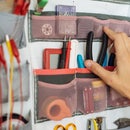Introduction: Three Fabric Buttons
I am also selling these handmade fabric buttons via Etsy. Although it is much cheaper to make your own, purchasing one will help me support my prototyping and development costs >>
http://www.etsy.com/shop.php?user_id=5178109'''
Step 1: Materials and Tools
MATERIALS:
- 1.5mm thick neoprene from http://www.sedochemicals.com
- Stretch conductive fabric from http://www.lessemf.com
also see http://cnmat.berkeley.edu/resource/stretch_conductive_fabric
- Fusible interfacing from local fabric store or
also see http://www.shoppellon.com
- Thread
- Pen and paper
(- LEDs and crocodile clips for testing)
TOOLS:
- Sewing needle
- Scissors
- Iron
(- Multimeter)
Step 2: Create a Stencil
Following these instructions you will be able to make fabric buttons whatever shape you like and it you don't need to make three, you can make just one or more by following the basic idea.
So for the first step you need to either recreate this stencil by tracing the in- or outside of your sticky tape roll to a strip of paper... or pick another object to trace...
Once you have your stencil, trace it two times onto the neoprene (or you can use any other fabric you want to work with. Felt also works well. And cut things out.
Then trace the stencil one more time onto the foam and cut this piece out slightly (2-3 mm) smaller than the tracing.
Step 3: Fusing Conductive Fabric
Fuse your fusible to one side of your conductive fabric and then trace pieces with tabs for each of your buttons and one larger piece with one tab for the common side. See the photos.
Cut these out and then fuse them to your pieces of neoprene. Make sure that none of your button tabs come out in the same place as your common tab. In the next step we will put a piece of perforated foam between these two conductive fabric fused neoprene layers and, when nothing is pushed, none of the individual pieces of conductive fabric should be touching.
Step 4: Making Holes
Using a hole making tool or pinching the foam with your fingernails, pluck or stance out holes either at regular intervals if you would like the buttons to be sensitive everywhere, or specifically in the center, or wherever you want the sensitive spot(s) to be. Holes should not be too big, 5-7 mm in diameter is usually great.
Step 5: Sewing Thing Together
Layer things together and sew around the edges, bringing the two layers of neoprene together (conductive fabric sides facing inwards) and sandwiching the perforated foam in between. Don't sew things too tightly or else you might create enough pressure to initially push the button(s) constantly.
Step 6: LED Test
Now, whichever button you press should light up the corresponding LED.
If an LED is constantly lit then you have a bad permanent connection. Try to see if you can see where two layers of conductive fabric might be touching?
If your LEDs don't light up at all:
- Make sure the battery is strong enough to power them all (touch LED directly to battery)
- Make sure your LEDs are oriented the right way (plus to plus, minus to minus)
- Did you forget to make holes in the foam?
ENJOY!
First Prize in the
SANYO eneloop Battery Powered Contest
Participated in the
SANYO eneloop Battery Powered Contest













